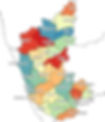Karnataka
- indiastatestories
- Jun 24, 2024
- 4 min read
Updated: Oct 31
The formation of Karnataka was a monumental step in unifying the Kannada-speaking population, creating a cohesive identity for the region. This journey involved the integration of five distinct administrative units from British India:
Mysore State: The heartland of Kannada culture, with its capital at Mysore, which was later pivotal in shaping the new state.
Hyderabad State: Kannada-speaking areas from the Nizam’s domain, including regions like Raichur and Gulbarga.
Madras Presidency: Parts of southern Karnataka, including Mangalore and Udupi, which are known for their coastal significance.
Bombay Presidency: Northern Karnataka districts, such as Belgaum and Dharwad, which were brought under the Kannada fold.
Coorg: A small but culturally rich region, known for its unique identity and contributions (Census of India, 2011).
This unification transformed the erstwhile Mysore state into Karnataka in 1973, which was followed by linguistic reorganisation of states realised on November 1, 1956 (SRC, 1955; Government of India, 1973). This symbolised the shared heritage and aspirations of Kannada speakers across the region.
In addition to the major presidencies and princely states, several minor princely states such as Jamkhandi, Mudhol, Ramdurg, Savanur, and Sandur – many of which had Kannada-speaking populations – were also merged post-independence, contributing to the territorial and cultural consolidation of the Kannada-speaking state (Menon, 1956).

Kannada speakers were spread across the following districts in different British provinces and princely states. Some princely states like Sangli and Ramdurg had scattered regions in modern-day Karnataka.
The unification movement was not only political but also cultural. Influential figures such as Aluru Venkata Rao (widely considered the "Father of Karnataka Ekikarana"), along with the Kannada Sahitya Parishat, played a crucial role in fostering a collective Kannada identity through literature and regional advocacy (Government of India, n.d.).

1920–1927 – Karnataka Ekikarana (Unification) Movement
The Ekikarana Movement aimed to unify Kannada-speaking regions, passing a resolution to achieve this goal. The Indian National Congress (INC) accepted linguistic redistribution of provinces as a political objective in 1920 at its Nagpur session. In 1927, the INC suggested that Andhra, Utkal, Sind, and Karnataka could form separate provinces based on language, traditions, and culture (SRC, 1955).
The movement gained further momentum in the early 1950s when the Government of India appointed the States Reorganisation Commission (SRC) in 1953, chaired by Fazl Ali. The SRC conducted an in-depth study and recommended the reorganisation of state boundaries primarily on linguistic lines, which directly facilitated the formation of a unified Mysore State (SRC, 1955).
1947 Integration into the Indian Union
The state of Mysore was one of the first to accede and integrate into the Union of India, with the Maharaja signing the Instrument of Accession and Standstill Agreement. The region was renamed Mysore State (Government of India, 1947). It had nine districts and was classified as a Part B state. Mysore's integration into the Indian Union was seamless. In August 1947, the Maharajah signed the Instrument of Accession and the Standstill Agreement. In June 1949, he revised it for broader legislative powers, except in taxes. Mysore joined the Federal Financial Integration in 1950 (Kumar, 2021).

It is important to note that not all integrations were straightforward. The Belgaum region, which had a significant Marathi-speaking population, became a point of contention between Karnataka and Maharashtra. This border dispute remains unresolved and continues to be politically sensitive (Times of India, 2021).
At the time of South Canara district’s transfer from Madras to Mysore state, a Kollegal taluk of Coimbatore state was also transferred to the state of Mysore on linguistic lines. Post-independence, Coorg was demarcated as a Part-C state and centrally administered (SRC, 1955; Government of India, 1956). The transfer of the Bellary district is also noteworthy – while the Kannada-majority taluks were retained by Mysore State, the Telugu-speaking areas of Bellary were transferred to the newly formed Andhra Pradesh (Government of India, 1968).
1953–1956: SRC and Formation of Mysore State
The Kannada-speaking regions of Bombay, Hyderabad, and Madras were integrated with Mysore. Considering Coorg’s greater linguistic and cultural linkages with Karnataka, it was added as well.

The States Reorganisation Act (1956) integrated Mysore State with the remaining areas from four different administrative regions (Coorg, Hyderabad, Bombay and Madras), making up the modern-day Karnataka state with 19 districts. These 19 districts included: Bangalore, Bellary, Bidar, Bijapur, Chikmagalur, Chitradurga, Coorg, Dakshina Kannada, Dharwad, Gulbarga, Hassan, Kolar, Mandya, Mysore, North Kanara, Raichur, Shimoga, South Kanara, and Tumkur (Government of India, 1956).

1973: Renaming of Mysore State
After the States Reorganisation Act of 1956, the unified state was still called Mysore State, which didn’t resonate with its newer districts. On 1 November 1973, Chief Minister Devaraj Urs renamed it as Karnataka, as the northern districts played a significant role in the Karnataka Ekikarana Movement (Government of India, 1973). Despite the unification, Karnataka faced internal challenges due to differing administrative legacies – such as revenue systems, judiciary frameworks, and land laws inherited from Hyderabad, Madras, Bombay, and princely Mysore.

References
Census of India (2011). Karnataka – Part-11: Administrative Divisions.
Government of India (1947). Instrument of Accession of the Maharaja of Mysore.
Government of India (1956). States Reorganisation Act.
Government of India (1968). Andhra Pradesh and Mysore (Transfer of Territory) Act 1968.
Government of India (1973). The Mysore State (Alteration of Name) Act, 1973.
Government of India (n.d.). Aluru Venkata Rao. Indian Culture.
Government of Karnataka n.d.). About districts.
Kumar, S. T. R., (2021). A throwback to Mysore Chalo. Deccan Herald.
State Reorganization Committee (1955). Report of the States Reorganisation Commission.
Menon, V. P., (1956). The Story of Integration of Indian States. Orient Blackswan
(2021). Explained: What is Belagavi border dispute between Karnataka and Maharashtra? Times of India.
